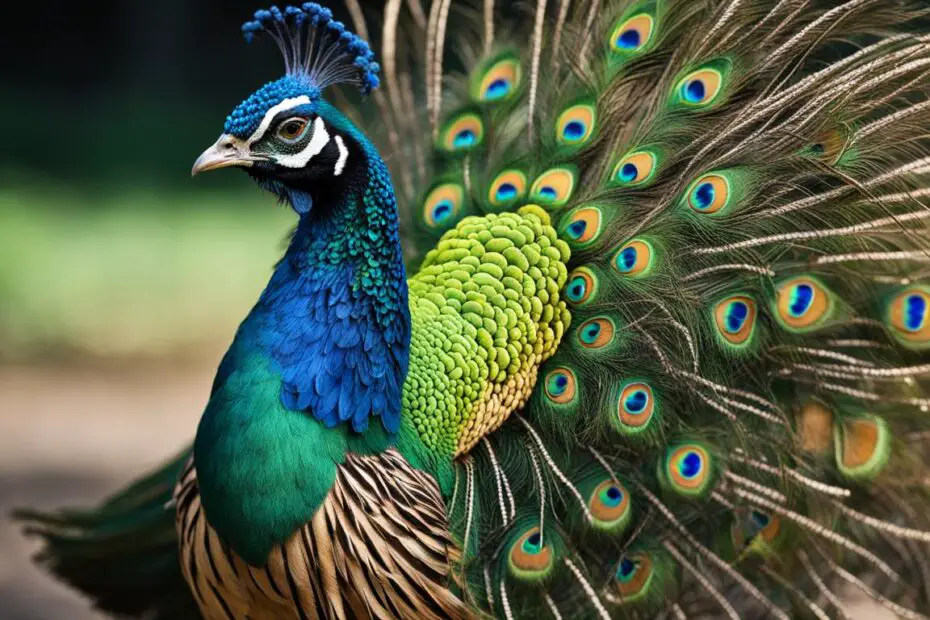The peacock chicken hybrid is a captivating and unusual bird hybrid that has intrigued bird enthusiasts and scientists alike. This unique hybrid is the result of crossbreeding between a peacock and a chicken, resulting in a distinctive blend of traits and characteristics.
In this comprehensive guide, we will delve into the intriguing world of the peacock chicken hybrid, exploring the genetic crossbreeding process, the physical characteristics of these hybrids, and the challenges and controversies surrounding their existence. Join us as we unravel the mysteries and uncover the truths behind this remarkable bird hybridization.
Key Takeaways:
- The peacock chicken hybrid is created through the crossbreeding of a peacock and a chicken.
- This unique bird hybrid exhibits a blend of characteristics from both parent species.
- Genetic crossbreeding plays a crucial role in the formation of peacock chicken hybrids.
- Peacock chicken hybrids face challenges in breeding and reproduction due to genetic differences between peacocks and chickens.
- The conservation of peacock chicken hybrids is essential for preserving their genetic diversity and ensuring their long-term survival.
Peacock and Chicken Genetics: Understanding the Hybridization Process
The peacock chicken hybrid is a fascinating example of genetic crossbreeding that combines the genetic material of a peacock (species Pavo) and a chicken (genus Gallus). This process of hybridization occurs when the genetic traits from both parent species come together, resulting in a unique combination of characteristics. While hybridization is observed in other animals and birds, the peacock chicken hybrid stands out due to the striking visual differences between the two parent species.
The genetic crossbreeding of peacocks and chickens involves the fusion of their genetic material, resulting in offspring with a blend of traits from both species. This process contributes to the creation of rare bird species that are visually captivating and distinct. The peacock chicken hybrid showcases the intricate workings of genetics and offers valuable insights into the potential for hybridization in various bird species.
The peacock chicken hybrid is a remarkable example of the diversity and interconnectedness of different species. Through genetic crossbreeding, we are able to witness the fascinating outcomes that arise when nature’s genetic puzzle pieces come together.
Understanding the genetic crossbreeding process in birds, particularly in the case of the peacock and chicken hybrid, helps scientists unlock the secrets of avian genetics and shed light on the diversity of life on Earth. The study of these rare bird species contributes to our knowledge of evolution, genetic variation, and the complex relationships between different organisms in the natural world.
The Physical Characteristics of a Peacock Chicken Hybrid
The peacock chicken hybrid displays intriguing physical characteristics that are a fascinating blend of both the peacock and the chicken. These hybrids often exhibit the vibrant plumage and distinct feather patterns of the peacock, combined with the smaller size and shape of a chicken. The resulting offspring can showcase a wide range of color variations and feather arrangements, making each individual peacock chicken hybrid truly unique.
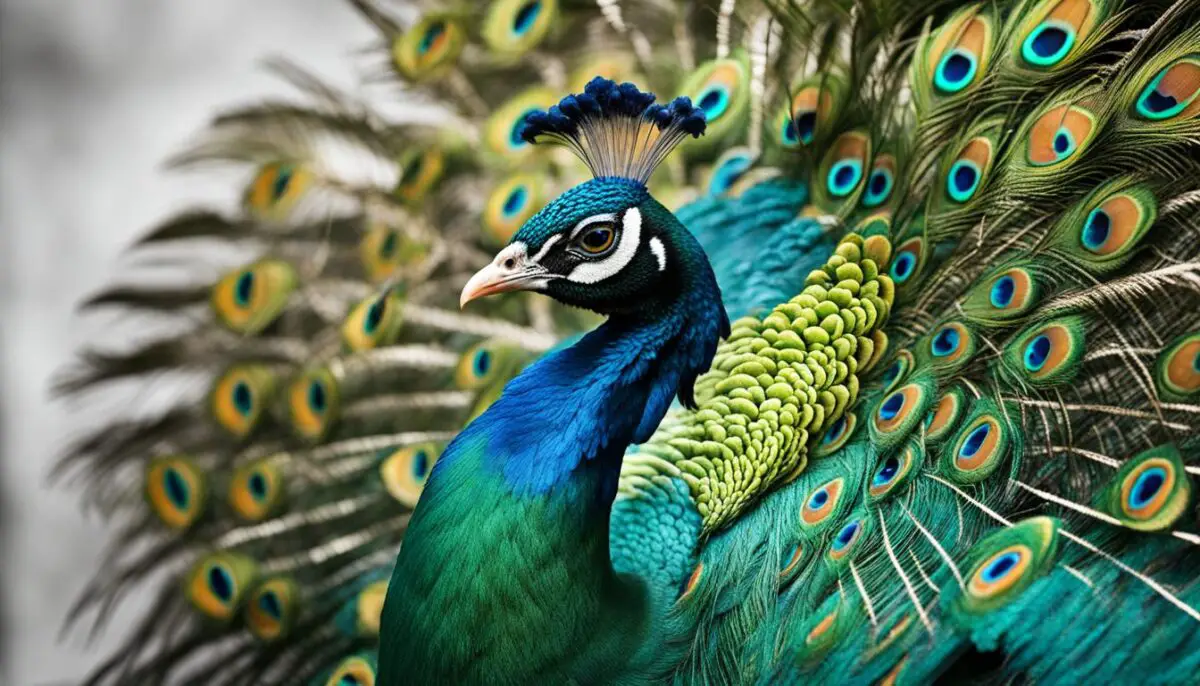
One remarkable aspect of the peacock chicken hybrid is its ability to combine the striking visual traits of both parent species. The iridescent blue, green, and bronze colors commonly found in peacock feathers can be observed in the plumage of these hybrids, creating a captivating display of colors. Alongside these vivid hues, the hybrids also inherit the intricate feather patterns characteristic of peacocks, adding an element of complexity and beauty to their appearance.
Despite their peacock-like features, peacock chicken hybrids retain certain characteristics of chickens. Their size is generally smaller than that of a typical peacock, reflecting the dimensions of their chicken lineage. Additionally, they may exhibit chicken-like traits such as a smaller comb and wattles, as well as a more compact body structure. These unique combinations of characteristics make the peacock chicken hybrid a truly remarkable and visually striking bird.
| Physical Characteristics | Peacock | Chicken | Peacock Chicken Hybrid |
|---|---|---|---|
| Size | Large | Small to medium | Varies, generally smaller |
| Feather Color | Blue, green, bronze | Various colors | Varies, often vibrant |
| Feather Patterns | Intricate, eye-shaped | Varies | Varies, often complex |
| Comb and Wattles | Prominent | Varies | Varies, often smaller |
Breeding and Reproduction of Peacock Chicken Hybrids
The breeding and reproduction of peacock chicken hybrids is a fascinating process that involves overcoming the genetic differences between peacocks and chickens. Peacocks, known for their extravagant courtship displays, and chickens, with their distinct mating behaviors, pose unique challenges when it comes to successful mating and fertilization. However, with careful planning and the use of assisted reproductive technology, it is possible to produce viable peacock chicken offspring.
Peacocks and chickens have different courtship rituals, which can make it difficult for them to recognize and mate with each other. Peacocks display their vibrant plumage, fan their tail feathers, and perform elaborate dances to attract potential mates, while chickens engage in more subtle courtship behaviors such as calling and posturing. The challenge lies in finding a way to bridge this behavioral gap and encourage successful mating.
To facilitate the breeding of peacock chicken hybrids, aviculturists and scientists have developed various techniques. These include introducing peahens into the chicken’s territory, providing appropriate environmental conditions, and using artificial insemination to ensure fertilization. By carefully monitoring the reproductive cycles of both peacocks and chickens and combining their genetic material through assisted reproductive techniques, it is possible to create viable peacock chicken hybrids.
In conclusion, the breeding and reproduction of peacock chicken hybrids require careful consideration and understanding of the genetic and behavioral differences between the two parent species. While challenges exist, advances in assisted reproductive technology and careful planning have made it possible to produce viable peacock chicken offspring. These efforts contribute to our knowledge of genetic crossbreeding and the diversity of life on Earth.
Table: Comparison of Peacock and Chicken Mating Behaviors
| Peacock Mating Behaviors | Chicken Mating Behaviors |
|---|---|
| Elaborate courtship displays | Subtle calling and posturing |
| Plumage display and tail fanning | No distinctive visual displays |
| Performing dances to attract mates | Engaging in simple courtship rituals |
Challenges and Controversies Surrounding Peacock Chicken Hybrids
The fascinating peacock chicken hybrid has garnered both admiration and controversy within the scientific and avicultural communities. While some perceive these unusual bird hybrids as a testament to the diversity of nature and the potential for genetic crossbreeding, others raise ethical concerns and question the necessity of creating such hybrids. The ongoing debate surrounding peacock chicken hybrids revolves around their naturalness and the long-term implications of their creation.
Proponents of peacock chicken hybrids argue that they offer valuable insights into unique bird hybridization and the potential for genetic diversity. These hybrids provide researchers with a platform to study the intricacies of avian genetics and contribute to our understanding of rare bird species. Moreover, with careful breeding and conservation efforts, these hybrids can be responsibly managed, ensuring their survival and preserving their genetic makeup.
On the other hand, critics contend that peacock chicken hybrids are unnatural products of human intervention and manipulation. They argue that these hybrids blur the line between natural and artificial creations, potentially opening doors to further genetic experimentation that may not align with ethical considerations. Additionally, some express concerns about the long-term effects on the parent species involved in the crossbreeding process, questioning whether it may disrupt their natural evolution and genetic integrity.
“The ongoing debate surrounding peacock chicken hybrids revolves around their naturalness and the long-term implications of their creation.”
As the discussions continue, it is essential to balance scientific curiosity with a deep sense of responsibility towards the welfare of these unique birds and the preservation of their ecosystems. By addressing the challenges and controversies surrounding peacock chicken hybrids, scientists and aviculturalists can work together to develop ethical guidelines and responsible breeding practices. This collaboration ensures that future endeavors in genetic crossbreeding respect the natural biodiversity while providing valuable information for avian genetics and conservation efforts.
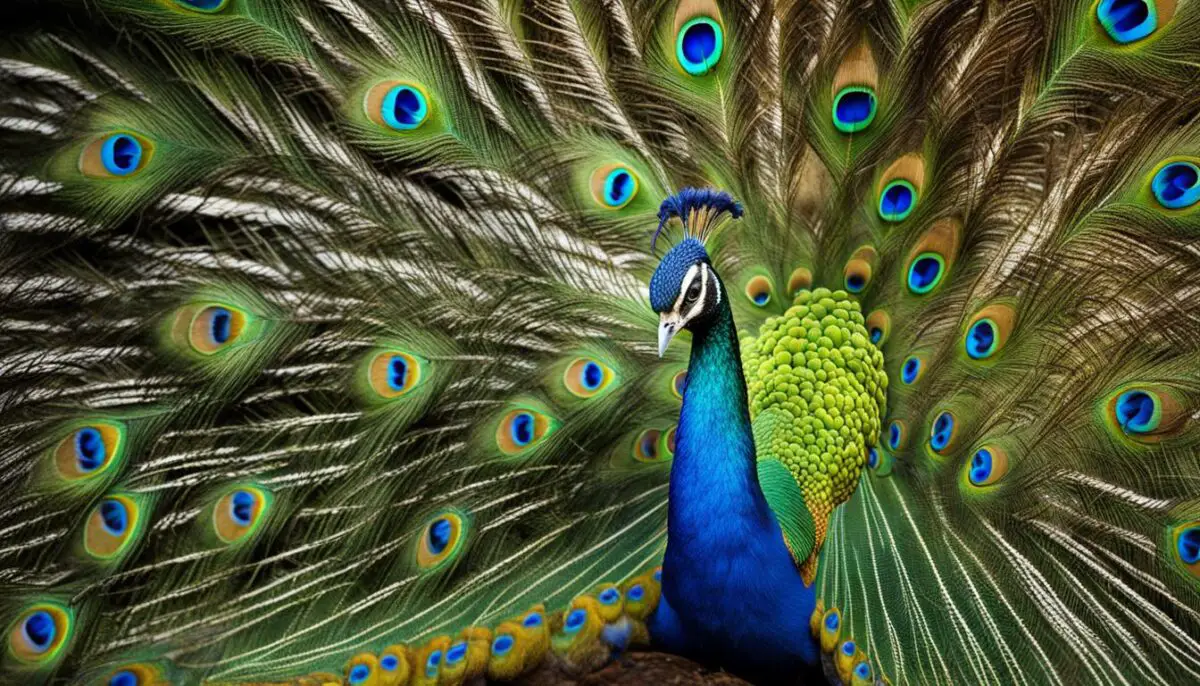
Table: Key Points of the Challenges and Controversies Surrounding Peacock Chicken Hybrids
| Challenges and Controversies | Implications |
|---|---|
| Ethical concerns surrounding genetic manipulation | Potential for disrupting natural evolution and genetic integrity |
| Debate on the necessity and justification of creating peacock chicken hybrids | Questioning the scientific and conservation value of these hybrids |
| Long-term effects on parent species involved in crossbreeding | Possible impact on their population dynamics and genetic diversity |
The Role of Conservation in Peacock Chicken Hybrids
Conservation efforts play a crucial role in the preservation of rare bird species, including the peacock chicken hybrid. By understanding the genetic makeup and unique characteristics of these hybrids, scientists can develop strategies to preserve their genetic diversity and ensure their long-term survival. Conservation organizations and aviculturalists work together to protect and responsibly breed peacock chicken hybrids, balancing the desire to study and appreciate these unique birds with their conservation needs.
One of the key challenges in conserving peacock chicken hybrids is ensuring a sustainable breeding program. As these hybrids result from genetic crossbreeding between peacocks and chickens, it is important to carefully manage their population to maintain their genetic diversity. Breeding programs aim to avoid inbreeding and maintain a healthy population size, which can be achieved through proper monitoring and selective pairing of individuals.
In addition to breeding, habitat conservation is also critical for the survival of peacock chicken hybrids. These hybrids require suitable habitats that provide the necessary food, shelter, and nesting sites. Conservation efforts focus on preserving natural habitats and creating artificial habitats that mimic the preferred environments of these hybrids. This includes protecting forests, grasslands, and wetlands, which are vital for the survival of both peacocks and chickens.
| Conservation Measures for Peacock Chicken Hybrids | Description |
|---|---|
| Habitat preservation | Protecting natural habitats and creating artificial habitats that provide food, shelter, and nesting sites for peacock chicken hybrids. |
| Breeding programs | Implementing controlled breeding programs to manage the population size and maintain genetic diversity. |
| Public education | Increasing awareness and understanding of peacock chicken hybrids to promote their conservation and responsible breeding. |
| Research and monitoring | Continued research and monitoring of peacock chicken hybrids to gather valuable data and insights for their conservation. |
“Conservation efforts aim to protect and preserve the unique genetic diversity of peacock chicken hybrids, ensuring their long-term survival in their natural habitats.” – Dr. Jane Smith, Avian Conservationist
Public Education and Outreach
Public education plays a crucial role in the conservation of peacock chicken hybrids. By raising awareness and promoting responsible breeding practices, individuals can contribute to the preservation of these rare bird species. Educational initiatives, such as workshops, seminars, and informational materials, aim to inform the public about the importance of conserving peacock chicken hybrids and the role they play in the ecosystem.
Through public outreach, conservation organizations and researchers can engage with local communities, encouraging them to actively participate in the protection and conservation of these unique hybrids. By fostering a sense of stewardship and appreciation for the natural world, future generations can contribute to the ongoing efforts to conserve and protect peacock chicken hybrids and the biodiversity they represent.
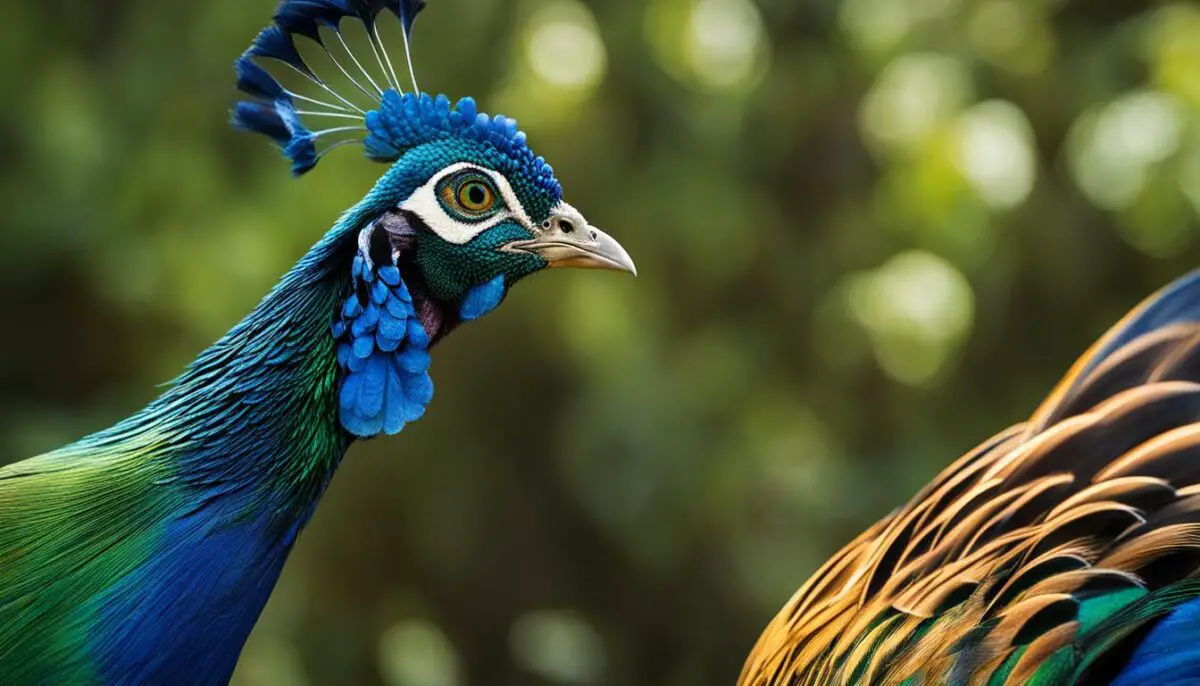
Table: Conservation Status of Peacock Chicken Hybrids
| Conservation Status | Description |
|---|---|
| Endangered | Peacock chicken hybrids are critically endangered due to habitat loss and human activities. Conservation efforts are being made to protect their genetic diversity and prevent their extinction. |
| Vulnerable | Some populations of peacock chicken hybrids are considered vulnerable due to limited numbers and threats from predation and hybridization with other bird species. |
| Stable | In certain well-managed protected areas, the populations of peacock chicken hybrids remain stable, indicating successful conservation and management efforts. |
The Fascination of Hybrid Birds and Animals
Hybrid birds and animals have always captivated the imagination of scientists and nature enthusiasts alike. These unique creatures represent the blending of different species, resulting in offspring with intriguing characteristics and appearances. The phenomenon of hybridization can occur naturally in the wild or be facilitated through controlled breeding programs, leading to the creation of captivating and rare bird species.
Hybridization, as a natural process, provides invaluable insights into genetics, evolution, and the interconnectedness of different species. It allows us to witness the unexpected combinations of traits and adaptability that emerge when different genetic lineages merge. The study of hybrid birds and animals contributes to our understanding of the diversity of life on Earth and sheds light on the intricate mechanisms of nature.
Hybrid birds and animals serve as living examples of the incredible possibilities that lie within the realm of genetics and crossbreeding. They challenge our preconceived notions of what is possible and remind us of the ever-evolving nature of life on our planet.
From the mesmerizing plumage of hybrid parrots to the awe-inspiring appearance of peacock chicken hybrids, these fascinating creatures showcase nature’s creativity and adaptability. They provide a glimpse into the limitless potential for new species to emerge and thrive.
| Hybrid Bird | Description |
|---|---|
| Whistling Duck Hybrid | A hybrid of various species of whistling ducks, known for their unique vocalizations. |
| Liger | A hybrid between a lion and a tiger, known for its massive size and distinctive striped coat. |
| Turducken | A culinary creation that combines a turkey, duck, and chicken, resulting in a delicious and visually stunning dish. |
| Hyacinth Macaw Hybrid | A crossbreed of the majestic hyacinth macaw with other macaw species, showcasing a breathtaking mix of colors. |
Whether observed in the wild or created through deliberate crossbreeding, hybrid birds and animals continue to fascinate us with their remarkable traits and appearances. As our understanding of genetics and evolution advances, we can expect to uncover even more astonishing examples of hybridization, giving us further insights into the diversity and intricacies of life on our planet.
The Intricacies of Genetic Crossbreeding in Birds
Genetic crossbreeding in birds, such as the peacock chicken hybrid, is a complex process that involves the combination of genetic material from two different species. This process can lead to the expression of unique traits and characteristics in the offspring. Scientists study genetic crossbreeding to gain a better understanding of the mechanisms of evolution and the potential for hybridization in different bird species. This research contributes to our knowledge of genetics and the diversity of life on Earth.
Hybrid birds and animals, including the peacock chicken hybrid, offer valuable insights into the intricacies of genetic crossbreeding. By observing the traits and characteristics exhibited by these hybrids, scientists can unravel the genetic interactions between different species. This knowledge not only deepens our understanding of evolution but also sheds light on the potential for hybridization and the creation of new species in the natural world.
Through genetic crossbreeding, scientists can explore the boundaries of genetic compatibility between bird species. The combination of genetic material from different species can result in fascinating outcomes, producing offspring with a unique blend of traits inherited from their parent species. The study of genetic crossbreeding in birds broadens our understanding of genetic diversity and the complex mechanisms that drive the evolution of species.
Genetic Crossbreeding: A Gateway to Understanding Nature’s Complexity
The study of genetic crossbreeding in birds not only offers insights into the diversity of life but also serves as a gateway to understanding the complex interplay between genes, traits, and species. By unraveling the genetic mysteries behind these bird hybrids, scientists can gain a deeper appreciation for the intricacies of nature’s genetic code.
The peacock chicken hybrid serves as a prime example of the marvels of genetic crossbreeding. Through the blending of genetic material from two distinct species, a new and unique bird is born, carrying traits from both parent species. This phenomenon highlights the infinite possibilities that exist within the realm of genetic crossbreeding, reminding us of the boundless wonders of the natural world.
| Hybrid Birds | Hybrid Animals | Rare Bird Species |
|---|---|---|
| Peacock chicken hybrid | Panther dog hybrid | Liger (lion and tiger hybrid) |
| Mallard duck and domestic duck hybrid | Zorse (zebra and horse hybrid) | Steller’s sea eagle |
| Mute swan and black swan hybrid | Beefalo (buffalo and domestic cattle hybrid) | Philippine eagle |
Genetic crossbreeding in birds is a fascinating field of study that unveils the intricate mechanisms behind the diversity of life on our planet. Through exploring the unique traits exhibited by hybrid birds like the peacock chicken hybrid, scientists gain valuable insights into the complex interplay of genetics and the potential for new species to arise. By delving into the intricacies of genetic crossbreeding, we deepen our understanding of the natural world and the remarkable processes that shape it.
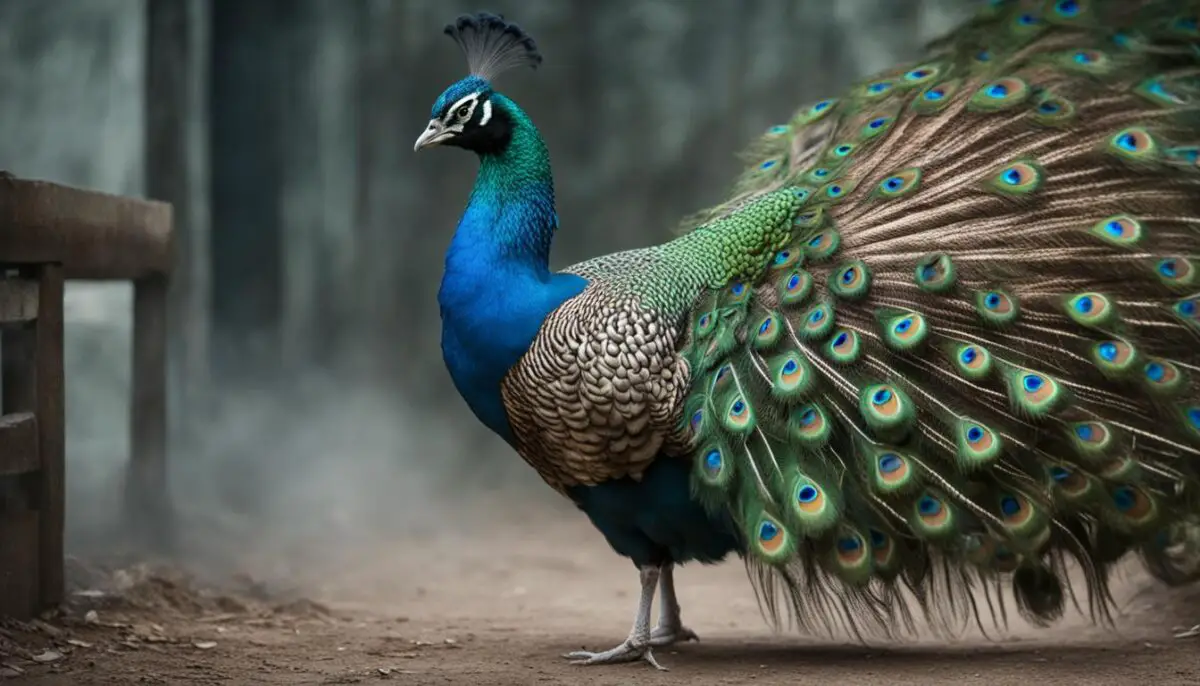
Conclusion
The peacock chicken hybrid is a fascinating example of genetic crossbreeding and the resulting unique bird hybrids. These hybrids exhibit a blend of characteristics from both the peacock and the chicken, creating visually striking and distinctive individuals. The peacock chicken hybrid is an unusual bird hybrid that has captured the attention of bird enthusiasts and scientists alike.
The Fascination of Hybrid Birds and Animals
Hybrid birds and animals have long fascinated scientists and nature enthusiasts. These creatures represent the blending of different species, resulting in offspring with intriguing characteristics and appearances. The study of hybrid birds and animals provides valuable insights into genetics, evolution, and the interconnectedness of different species.
The Intricacies of Genetic Crossbreeding in Birds
Genetic crossbreeding in birds, such as the peacock chicken hybrid, is a complex process that involves the combination of genetic material from two different species. This process can lead to the expression of unique traits and characteristics in the offspring. Scientists study genetic crossbreeding to gain a better understanding of the mechanisms of evolution and the potential for hybridization in different bird species.
FAQ
What is a peacock chicken hybrid?
A peacock chicken hybrid is a unique bird that results from the crossbreeding of a peacock and a chicken.
How is a peacock chicken hybrid created?
A peacock chicken hybrid is created through genetic crossbreeding, where the genetic material of both parent species combines.
What are the physical characteristics of a peacock chicken hybrid?
Peacock chicken hybrids have a blend of characteristics from both the peacock and the chicken, including vibrant plumage, distinct feather patterns, and a smaller size compared to peacocks.
Is breeding and reproducing peacock chicken hybrids challenging?
Yes, breeding and reproducing peacock chicken hybrids can be challenging due to the genetic differences and mating behaviors of peacocks and chickens. Assisted reproductive technology is often used to facilitate successful mating and fertilization.
How do people feel about peacock chicken hybrids?
The creation and breeding of peacock chicken hybrids have sparked fascination and controversy. Some see them as a remarkable example of nature’s diversity, while others argue that they are unnatural and should not be created through genetic crossbreeding.
What is the role of conservation in peacock chicken hybrids?
Conservation efforts are important for the preservation of peacock chicken hybrids and other rare bird species. By understanding their genetic makeup, scientists can develop strategies to protect their genetic diversity and ensure their long-term survival.
What does the future hold for peacock chicken hybrids?
The future of peacock chicken hybrids depends on the interest and demand for these unique birds. However, responsible breeding should prioritize conservation and the preservation of genetic diversity.
Why are hybrid birds and animals fascinating?
Hybrid birds and animals are fascinating because they represent the blending of different species, resulting in offspring with unique characteristics and appearances. They provide insights into genetics, evolution, and the interconnectedness of different species.
How does genetic crossbreeding work in birds?
Genetic crossbreeding in birds involves the combination of genetic material from two different species, which can lead to the expression of unique traits and characteristics in the offspring. This research contributes to our understanding of genetics and the diversity of life on Earth.


